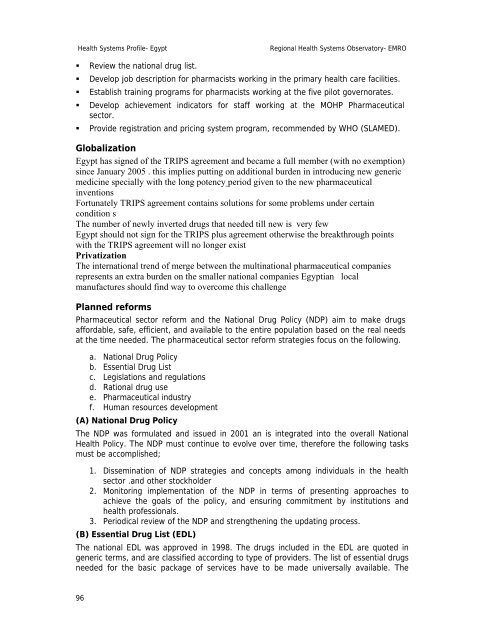Egypt : Complete Profile - What is GIS - World Health Organization
Egypt : Complete Profile - What is GIS - World Health Organization
Egypt : Complete Profile - What is GIS - World Health Organization
Create successful ePaper yourself
Turn your PDF publications into a flip-book with our unique Google optimized e-Paper software.
<strong>Health</strong> Systems <strong>Profile</strong>- <strong>Egypt</strong> Regional <strong>Health</strong> Systems Observatory- EMRO<br />
Review the national drug l<strong>is</strong>t.<br />
Develop job description for pharmac<strong>is</strong>ts working in the primary health care facilities.<br />
Establ<strong>is</strong>h training programs for pharmac<strong>is</strong>ts working at the five pilot governorates.<br />
Develop achievement indicators for staff working at the MOHP Pharmaceutical<br />
sector.<br />
Provide reg<strong>is</strong>tration and pricing system program, recommended by WHO (SLAMED).<br />
Globalization<br />
<strong>Egypt</strong> has signed of the TRIPS agreement and became a full member (with no exemption)<br />
since January 2005 . th<strong>is</strong> implies putting on additional burden in introducing new generic<br />
medicine specially with the long potency period given to the new pharmaceutical<br />
inventions<br />
Fortunately TRIPS agreement contains solutions for some problems under certain<br />
condition s<br />
The number of newly inverted drugs that needed till new <strong>is</strong> very few<br />
<strong>Egypt</strong> should not sign for the TRIPS plus agreement otherw<strong>is</strong>e the breakthrough points<br />
with the TRIPS agreement will no longer ex<strong>is</strong>t<br />
Privatization<br />
The international trend of merge between the multinational pharmaceutical companies<br />
represents an extra burden on the smaller national companies <strong>Egypt</strong>ian local<br />
manufactures should find way to overcome th<strong>is</strong> challenge<br />
Planned reforms<br />
Pharmaceutical sector reform and the National Drug Policy (NDP) aim to make drugs<br />
affordable, safe, efficient, and available to the entire population based on the real needs<br />
at the time needed. The pharmaceutical sector reform strategies focus on the following.<br />
a. National Drug Policy<br />
b. Essential Drug L<strong>is</strong>t<br />
c. Leg<strong>is</strong>lations and regulations<br />
d. Rational drug use<br />
e. Pharmaceutical industry<br />
f. Human resources development<br />
(A) National Drug Policy<br />
The NDP was formulated and <strong>is</strong>sued in 2001 an <strong>is</strong> integrated into the overall National<br />
<strong>Health</strong> Policy. The NDP must continue to evolve over time, therefore the following tasks<br />
must be accompl<strong>is</strong>hed;<br />
1. D<strong>is</strong>semination of NDP strategies and concepts among individuals in the health<br />
sector .and other stockholder<br />
2. Monitoring implementation of the NDP in terms of presenting approaches to<br />
achieve the goals of the policy, and ensuring commitment by institutions and<br />
health professionals.<br />
3. Periodical review of the NDP and strengthening the updating process.<br />
(B) Essential Drug L<strong>is</strong>t (EDL)<br />
The national EDL was approved in 1998. The drugs included in the EDL are quoted in<br />
generic terms, and are classified according to type of providers. The l<strong>is</strong>t of essential drugs<br />
needed for the basic package of services have to be made universally available. The<br />
96

















